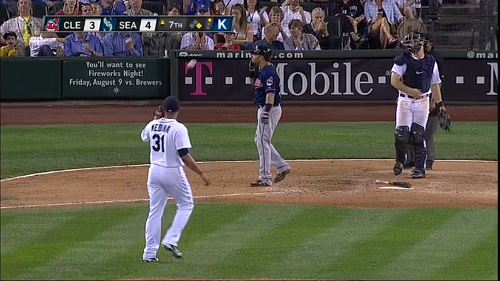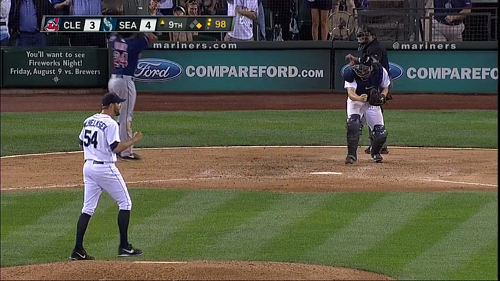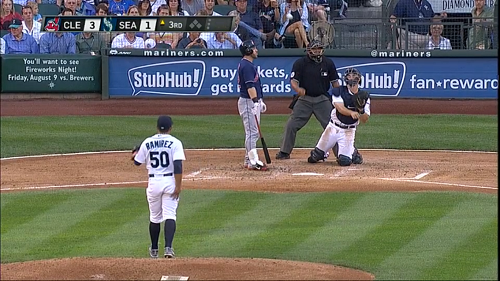What You Knew I Was Going To Write About Mike Zunino
I’ve never seen an episode of The Wire. I’ve never seen five minutes of an episode of The Wire. I have seen one clip, hosted on YouTube, but I didn’t know it was going to be a clip of The Wire when I went there, so in that sense it was an accident. I’m not bragging and I don’t have anything personally against the series. My understanding is that the series is supposed to be fantastic — one of the best series put together in at least the recent history of television. That’s what everybody says. But that’s the problem: that’s what everybody says. The show is too beloved, too popular, too often talked about on the Internet in which I exist. I do intend to watch The Wire someday, but for now I’m already sick of hearing about it, and I’ll watch it when no one’s gushed about it to me for a calendar year. I mean, I ride the tide with Breaking Bad, and I live with it, but the Internet’s been on The Wire like the Internet’s been on bacon and I just don’t care. Shut up and let me learn to care on my own.
So I wouldn’t blame you if you’re already tired of reading about pitch-framing, or pitch-receiving, or whatever you want to call it. Over the years since pitch-framing was really quantified and made public, it’s taken baseball analytics by storm, and the community has turned Jose Molina into a cult hero. People are hyper-aware of framing now, they’re looking for it on every pitch, and people talk about framing like nothing else a catcher has to do matters. At least, like nothing matters as much. Because framing research still has that new-car smell, it’s a popular thing to talk about, and maybe that makes the discussion repetitive and overwhelming.
But, whatever, I’m here to talk about framing, and I’m here with a positive message, that you’re free to accept or ignore. Mike Zunino has been up with the Mariners for a short while, now. It’s too soon to know what to make of his offense, and that part of his game is still being polished. His defense, though, has long been considered his strength, and based on the evidence to date, receiving is one of his skills.
That shouldn’t be surprising, in that Zunino’s always been billed as a plus defender. That should be surprising, because Rob Johnson was supposed to be a good defender too until it turned out he sucked. That should be surprising, because the Mariners haven’t had a decent framer for a while, excepting Jesus Sucre, who was never supposed to be in the plans. For years, the Mariners pitched to a shrunken strike zone. Now, this is a whole new experience.
Let’s look just as last night, for a moment. A good indicator of good framing is when the hitter responds to a call all angry-like. Last night, Zunino was the Mariners’ catcher, and here are some selected screenshots:
Zunino, yesterday, seemed to buy the Mariners some calls. The final pitch of the game was one such call. But, all right, when you’re looking at one game, you can be influenced by any number of variables, most obviously the home-plate umpire. You need to look at a broader range of information. I want to show you something. Using plate-discipline data available at FanGraphs, I’ve been able to come up with a home-brewed receiving metric. It isn’t catcher-specific, but it is team-specific, and it compares actual strikes against expected strikes, based on pitches in the zone and whatnot. A positive number means more strikes than expected, suggesting good catching. A negative number means fewer strikes than expected, suggesting bad catching. Let’s look at where the Mariners have ranked in this statistic, broken down by month:
April: 30th (last)
May: 24th
June: 12th
July: 4th
Zunino arrived in the middle of June. In April, Jesus Montero got 52% of the starts, and the Mariners were dreadful. In May, the playing-time leader was Kelly Shoppach, at 42% of starts. In June, Zunino was the playing-time leader, at 41% of starts. In July, it’s been 83% Zunino and 17% Henry Blanco. As Zunino has played more and more often, the Mariners have pitched to a strike zone more and more generous, or at least more and more fair.
Of course, it isn’t all Zunino. Sucre received well before he got hurt, and Blanco has a strong reputation. In order to focus on Zunino specifically, I called on Matthew, who keeps his own pitch-framing numbers. Matthew generously helped me out. Zunino has caught some thousands of pitches. Matthew calculates his own strike zone, based on what umpires actually call, as opposed to what the rule book dictates. With Zunino, 91% of pitches taken in the zone have been called strikes. The league average is about 86%. With Zunino, also, 7% of pitches taken out of the zone have been called strikes, which is right on the average. It’s not so much that Zunino gets extra calls by the barrelful; it’s that he gets the calls the team deserves, mostly. Compared to an average catcher, Zunino’s averaged better than one more strike per game. That ranks him highly among his peers, albeit below the very best.
A bit of a conversation from last night, after Yoervis Medina and Mike Zunino froze Nick Swisher:
Blowers: …think you give Mike Zunino some credit on that strike, that pitch looked like it was just off the plate, running off the outside corner, but Zunino does a good job of framing it and holding it there on the corner for umpire Adrian Johnson.
Wilson: Yeah, outstanding job to kinda…stick that pitch on the outside corner, fool the umpire a little bit.
So Dan Wilson did that thing he does where he talked without introducing any new information, just repeating the guy who talked before him, but Blowers spotted the receiving and Wilson — a good defensive catcher! — agreed. In that case, Zunino bought the Mariners an iffy strike. More often, he just gets the strikes that probably ought to be strikes, where a lot of catchers give them away near the edges.
Framing is probably one area where we don’t need to worry about age-related decline or sudden other changes. How you catch is how you catch, and though Zunino isn’t flawless and entirely motionless, the results are the results and he looks more good than bad to the eye. He keeps his body quiet and there’s hardly anything in the way of pointless motion. Because it’s only been a handful of weeks we will, of course, need to look at this information again down the road, but I feel good about this. To the eye, Zunino knows how to catch, and by the numbers, that statement is supported.
And oh, by the way, Zunino’s shown a better hitting approach in July than he did in June, not that those samples can really tell you much. He’s dropped his swing rate from 53% to 45%, and he’s gone from two walks and 11 strikeouts to seven walks and 15 strikeouts. That’s a positive step, but it might be nothing, and we’ve known for a while that Zunino’s hitting is a work in progress. What he is now, he shouldn’t be later on. At the plate, Mike Zunino is still learning, and he should be a better hitter a year from now.
Behind the plate? Zunino’s still learning about the majors and about a major-league pitching staff, but he seems to do most everything right. I liked Jesus Sucre simply because he was defensively capable. Mike Zunino is defensively capable, but he’s also an actual prospect with overall upside. This one should be a good one, and already, he’s a good one in a way in which the Mariners haven’t been good for a while.
Comments
15 Responses to “What You Knew I Was Going To Write About Mike Zunino”
Leave a Reply
You must be logged in to post a comment.




A few of us were commenting during yesterday’s game thread about this – what a pleasure it is to watch an actual defensively competent catcher!
One or two guys advocated for Joh as being good defensively – but (looking at primary catchers only) the most recent consensus pick was Danny Wilson. That’s a lot of sucky catchers between Wilson (or even Johjima) and Zunino!
Indeed it is. At his age, the defense is highly encouraging. Teams can put up with severely depressed offensive numbers from a rally good defensive catcher. Framing, blocking, throwing all seem to be strengths, and I’ve never believed a ton in “game-calling” but thats something that comes with time anyway.
A high level defensive catcher is a positive if he can OPS even .700. I think most see Zunino being well above that mark. Let’s just hope he continues to improve.
I often appreciate Mike Blowers on the broadcasts.
So is it fair to say that after years of Johnson, Clement, Olivo, Montero, etc., the M’s found glove in a hopeless place?
I’ll show myself out.
I love when the stats back up your first take on a player. Definitely excited to see what Zunino can become as an all around player!
Whatever happened to Sucre anyway? When he got hurt, the reports made it sound like he may only miss a few days. Haven’t heard a word about him since.
When they brought up Zunino, despite the media arguments that it was only a stopgap (which made little sense) – I suspect the decision was made to have Sucre take one for the team.
If you look at Gameday, the Wilhelmsen game ender to Bourn was right on the black. So they deserved that one.
However the strike out to Swisher was definitely off the plate. It looks like its even outside the typical lefty strike zone.
The M’s weren’t going to sign Blanco then DFA him in a week or two to bring Sucre back. I’ve got a feeling Sucre is slotted to the be the backup catcher next year, but Hicks might be in the mix too. However Hicks has taken a big step back offensively this year he tore up A ball last year, AA not so much:
2012 (A+) .312/.351/.472
2013 (AA) .226/.276/.327
Two pitches to Bourn in this game that were strike three. One time he walked, the next time, he hit a grand slam on the next pitch.
I wonder if Zunino would have done different.
The Wire is a delicious fruit that is permanently ripe. Enjoy it now or in a year.
Yes Gar-
They were…
“Looking for glove/In all the wrong places… Looking for glove/In too many faces…”
Thought I’d spread the groans around for you…
I read yesterday’s thread where folks were talking about Zunino, and I myself last week brought up in a thread how refreshing it was that of all the things we worry about with the Mariners these days, nobody is still talking about “why can’t we get a catcher who can catch?”
That in itself is refreshing. It’s a non-issue suddenly. That’s a HUGE change/improvement.
And if catching is given a big plus in positional adjustments, then the M’s have made, in relative terms, a HUGE defensive adjustment in the past month, just by how far they’ve jumped up the catcher adjustment scale between Montero and Zunino.
The M’s weren’t going to sign Blanco then DFA him in a week or two to bring Sucre back.
Sucre wasn’t (isn’t) on the 60. You could have speculated that Zunino would go down when he was ready, no 40 man move necessary.
Not that it matters now.
You counter-culture bastard… WATCH THE WIRE! We need more (read: any) posts comparing Wire characters to Mariners players, by jove!
Thank you for not watching The Wire, just to have a dissenting voice.
If Zunino is good defensively and comfortable with it, as he appears to be, it may help with his progress hitting not to have to try and learn to catch at the same time.
You realize that when you don’t watch something based on too much internet hoo-hah, you are just as much affected by the internet hoo-hah as watching it because of the hoo-hah. The only thing to do is watch it or don’t watch it, and the hell with the hoo-hah.
(Data: I watched The Wire for a few shows in the first season despite my extreme distaste for tv drama. It was good. I didn’t feel a need to watch more. End data.)